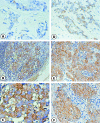Increased expression of connexins 26 and 43 in lymph node metastases of breast cancer
- PMID: 16567471
- PMCID: PMC1860373
- DOI: 10.1136/jcp.2005.029272
Increased expression of connexins 26 and 43 in lymph node metastases of breast cancer
Abstract
Background: Gap junctions are intercellular channels composed of connexins, which mediate the direct passage of small molecules between neighbouring cells. They are involved in regulation of cell cycle, cell signalling, and differentiation, and probably invasion and metastasis. The role of connexins in the metastatic process is controversial, because some studies indicate that connexin expression is inversely correlated with metastatic capacity. In contrast, others demonstrate that connexins may be involved in metastasis. In addition, connexin status in breast cancer metastasis has not been widely studied.
Methods: We evaluated by immunohistochemistry the expression of connexin 26 (Cx26) and connexin 43 (Cx43) in primary breast tumours (PTs) and matched paired metastases to lymph nodes (MLNs).
Results: In PTs, we observed predominantly cytoplasmic localisation of evaluated connexins, indicating alterations in connexin expression in breast cancer cells. We demonstrated that expression of Cx26 and Cx43 was increased in MLNs compared with PTs (p<0.00001 and p<0.001, for CX26 and Cx43, respectively). In addition, Cx26 and Cx43 negative PTs developed Cx26 and Cx43 positive MLNs. Furthermore, besides increased cytoplasmic staining, enhanced membranous localisation of Cx43, typical of normal cells, was found in MLNs. Additionally, membranous Cx26 expression appeared only in metastatic breast cancer cells.
Conclusions: These findings suggest that connexins may contribute to the efficient metastasising of breast cancer to the lymph nodes.
Similar articles
-
Increased expression of gap junction protein--connexin 32 in lymph node metastases of human ductal breast cancer.Folia Histochem Cytobiol. 2007;45 Suppl 1:S175-80. Folia Histochem Cytobiol. 2007. PMID: 18292829
-
Connexins 26 and 43 correlate with Bak, but not with Bcl-2 protein in breast cancer.Oncol Rep. 2005 Aug;14(2):325-9. Oncol Rep. 2005. PMID: 16012710
-
Expression of gap junction proteins connexin 26 and connexin 43 in normal human breast and in breast tumours.J Pathol. 1998 Jan;184(1):37-43. doi: 10.1002/(SICI)1096-9896(199801)184:1<37::AID-PATH966>3.0.CO;2-D. J Pathol. 1998. PMID: 9582525
-
Expression pattern of different gap junction connexins is related to embryo implantation.Int J Dev Biol. 1996 Feb;40(1):361-7. Int J Dev Biol. 1996. PMID: 8735949 Review.
-
Connexins and gap junctions in mammary gland development and breast cancer progression.J Membr Biol. 2007 Aug;218(1-3):107-21. doi: 10.1007/s00232-007-9052-x. Epub 2007 Jul 28. J Membr Biol. 2007. PMID: 17661126 Review.
Cited by
-
Expression and significance of Cx43 and E-cadherin in gastric cancer and metastatic lymph nodes.Med Oncol. 2011 Jun;28(2):502-8. doi: 10.1007/s12032-010-9492-5. Epub 2010 Apr 6. Med Oncol. 2011. PMID: 20373058
-
Epithelial and mesenchymal phenotypic switchings modulate cell motility in metastasis.Front Biosci (Landmark Ed). 2011 Jan 1;16(3):815-37. doi: 10.2741/3722. Front Biosci (Landmark Ed). 2011. PMID: 21196205 Free PMC article. Review.
-
Mechanism of Regulatory Effect of MicroRNA-206 on Connexin 43 in Distant Metastasis of Breast Cancer.Chin Med J (Engl). 2016 Feb 20;129(4):424-34. doi: 10.4103/0366-6999.176071. Chin Med J (Engl). 2016. PMID: 26879016 Free PMC article.
-
Comprehensive Pan-Cancer Analysis of Connexin 43 as a Potential Biomarker and Therapeutic Target in Human Kidney Renal Clear Cell Carcinoma (KIRC).Medicina (Kaunas). 2024 May 8;60(5):780. doi: 10.3390/medicina60050780. Medicina (Kaunas). 2024. PMID: 38792963 Free PMC article.
-
Connexins-Therapeutic Targets in Cancers.Int J Mol Sci. 2020 Nov 30;21(23):9119. doi: 10.3390/ijms21239119. Int J Mol Sci. 2020. PMID: 33266154 Free PMC article. Review.
References
-
- el‐Sabban M E, Pauli B U. Adhesion‐mediated gap junctional communication between lung‐metastatatic cancer cells and endothelium. Invasion Metastasis 199414164–176. - PubMed
Publication types
MeSH terms
Substances
LinkOut - more resources
Full Text Sources
Other Literature Sources
Medical
Miscellaneous

